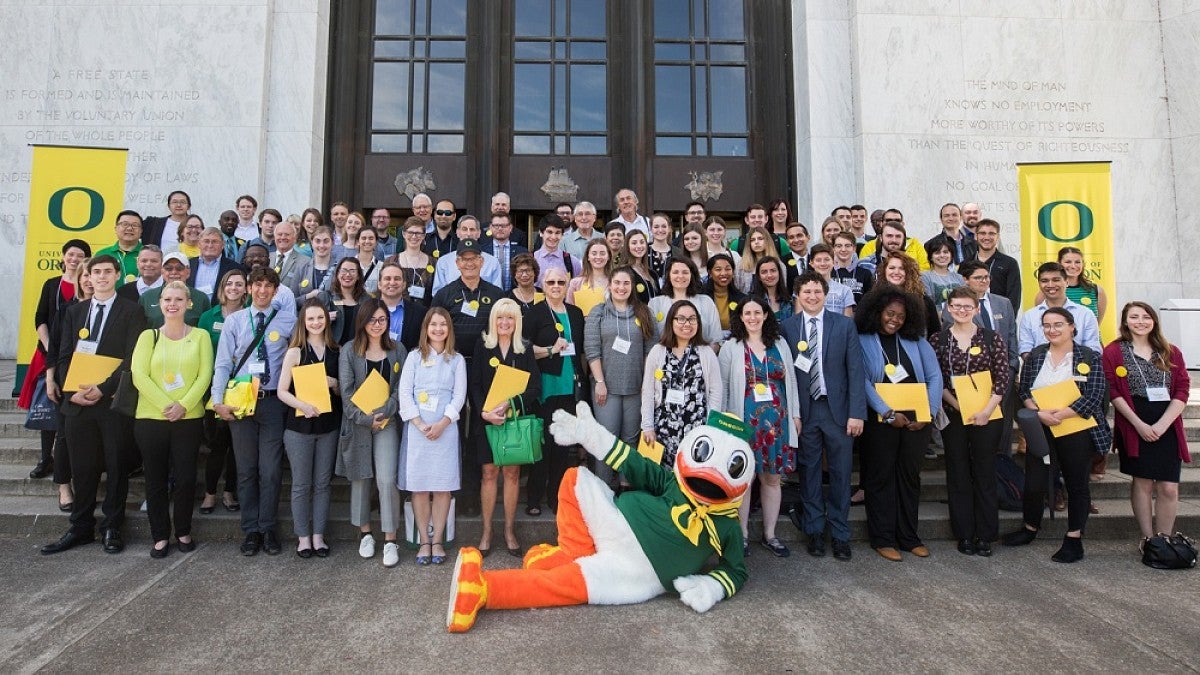On Wednesday, May 8, more than 110 students, alumni, faculty members and staff from the University of Oregon traveled to the state Capitol in Salem to lobby legislators for increased funding for the UO and higher education.
Advocates told lawmakers and their staffs that public universities need the Public University Support Fund to grow by at least $120 million to keep tuition increases at or below 5 percent next year. The UO receives approximately 22 percent of the state fund based on a formula established by the Higher Education Coordinating Commission.
The fund is currently budgeted at $737 million for the 2017-19 biennium. That level of funding reflects increases since 2015, but it is still below prerecession funding levels. Oregon is now ranked 37th in the nation for state funding per student, according to data from the State Higher Education Executive Officers Association.
“It was so exciting to see so many students turn out to engage in political advocacy,” said Maria A. Gallegos-Chacón, the UO student body president. “I hope that legislators also took note of the sacrifices students took to be talking to them today by missing class, work and using their time to let legislators how critical it is we be taken into account.
“Overall, I am disappointed with the lack of public support for higher education investment on behalf of legislators. I hope legislators will take funding seriously when it comes to cradle-to-career education and not just say it, but show with their stances and votes that they are here for Oregonian students.”
Advocates arrived at the Capitol in the morning, received an orientation and welcome from President Michael Schill and Gov. Kate Brown, and met with legislators throughout the day. The UO a capella group Mind the Gap performed at the opening ceremonies of the House of Representatives floor session, and UO academic and service programs hosted booths set up in the Capitol galleria.
The booths included the university’s prison education program; Oregon Research Schools Network; Sustainable City Year Program; Oregon Institute of Marine Biology, whose staff brought live dungeness crabs and jellyfish; and the UO’s earthquake early warning system, called ShakeAlert. The UO Alumni Association also hosted a galleria table and encouraged policy staff and visitors in the building to answer UO-related trivia questions.
“Our goal at the UO is to reduce student debt, improve graduation rates, provide critical wraparound services and ultimately create a better-equipped workforce for the future of Oregon’s economy,” said Libby Batlan, associate vice president of state and community affairs. “Cutting through the noise in Salem can be tough, but when lawmakers hear directly from students, alumni, faculty and staff about why investment in higher education is important, that’s when real change is made.”
The Legislature is less than two months away from the conclusion of the 2019 session and setting the state’s budget for the next two years. Lawmakers will wait until after the Oregon economic forecast May 15 before making any final decisions in order to better understand how much revenue will flow into state coffers from taxpayers and businesses.


